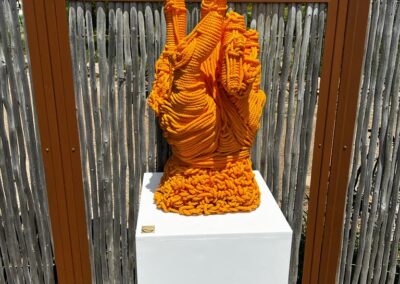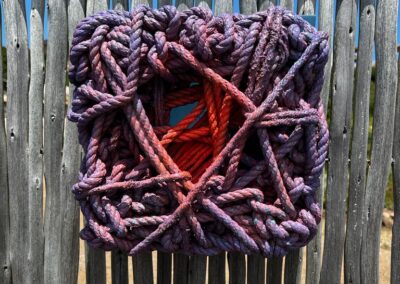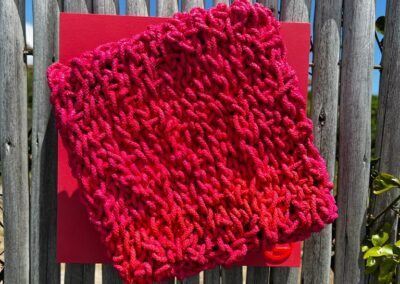ARTISTS
Emanuela Giacco
Artist’s card

Emanuela was born in L’Aquila in 1983, showing her penchant for art from an early age. In the halls of one of her antiquarian uncles she would be enraptured by the works for hours, keeping that thought vivid in her heart; as a child she continued to see herself there, motionless, enraptured by the grandiose canvases of the 1600s. But her creativity meets and collides with parallel scientific training. In fact, she graduated in engineering, and began a path as an artist-engineer that soon led her to a crossroads. Her move to Rome in 2012 marks a major change. The continuous struggle between dream and logic induces her to lead an energetic life, marked by a constant metamorphosis, strengthened by her meeting with the president of the Giorgio and Isa De Chirico Foundation, Prof. Paolo Picozza, with whom, in December 2016, she organized her first solo exhibition at the Foundation’s headquarters on Via dei Tre Orologi. He decided from there on to devote himself completely to his deepest passion: art. Another angel she met on her path was Marina Mattei, archaeological curator of the Capitoline Museums, a figure who soon became for her a mentor as well as a friend. In 2017 she began living between Rome and Salerno, altering the energy of the Amalfi Coast to the powerful charge of Rome.
Since then she begins to participate in exhibitions to open herself up to confrontation with artists and constant encounters with the public, welcoming different challenges in form and content.
He has exhibited in Florence, Genoa, L’Aquila, La Spezia, Mantua, Milan, Olbia, Palermo, Poltu Quatu, Porto Rotondo, Rome, Sorrento, Turin, Venice, Barcelona, Bruges, and Paris. He moved back to L’Aquila in 2019,where he had the pleasure of collaborating with master Raimondo Tiberio, thus approaching the world of sculpture. In the midst of the Pandemic, in April 2020 he moved to Sardinia, where he still lives. The energy of these territories is so intense that it allows her to approach something more material; to the ropes of her paintings she juxtaposes installations of nautical ropes, thus her first textile sculpture, wins in August the first prize of the 4th edition “Le Quai Des Artistes” in Porto Rotondo, strongly desired by Count Luigi Doná dalle Rose with his foundation. From there on he continues to work on the chapter of works related to textile sculptures, made from discarded nautical ropes, works of art that are spokespersons for the love of the planet, thus focusing attention on environmental issues, trying to involve as much as possible the public, organizations and entities that in some way can contribute to safeguarding what we have most precious: the Earth, our home.
His research has an existentialist matrix. In the works he emphasizes the complexity of human beings made by the layering of genetic, moral and cultural codes. He refers to the dual nature of all those constraints that human beings experience in the course of their existence, arriving at a historical discourse that traces the entire journey of man from his origins to the present. The summit as a symbolic and expressive element that encapsulates all of his research. The summit as a symbol of the bonds that are part of every person’s existence. The top responds to the law of the logarithmic spiral, a structure ubiquitous in nature from DNA to galaxies. The top, on a purely formal level, is related to the Fibonacci series, which expresses the concept of beauty and harmony. The line, being a salvage line, speaks of history, carries with it the energy of the hands that have caressed or tugged at it, carries with it the flavor of the seas it has sailed. The summit tells stories of ties, of the superstructures and entanglements of the human unconscious that have never been loosened. Bonds as the individual bonds, but also as the set of superstructures that lead the individual’s choices to be continually and inevitably conditioned by place, historical period, culture, and religion. Being aware of them or not determines their value within one’s experience. The interweaving of knots as the “Ego” representation of each individual reconnecting to the “Whole.” Hence the connection with nature, which becomes a central theme also embracing the world of sustainability. Thus sustainability becomes the watchword. Art has always questioned the present moment, told of changes, revolutions sometimes anticipating them. The artist believes that art today cannot help but talk about the climate crisis. He believes in a project that awakens social consciences. Tons of synthetic textile fibers are disposed of every year, and in the worst cases they are dumped into the seabed affecting posidonia and all species. He believes that art speaks through emotions, which is why the message conveyed will always be very powerful. The textile sculptures are in fact made from salvaged tops thus encapsulating the synthesis of his research, existentialism, nature and sustainability.




